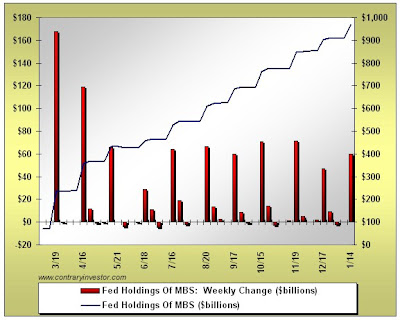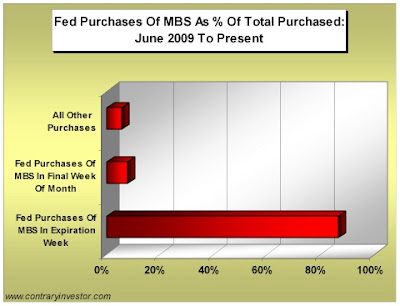Is the Fed Timing Its MBS Purchases To Add Liquidity to the Banks at Monthly Options Expiration?
Courtesy of Jesse’s Café Américain
Our friends at ContraryInvestor have published some remarkable data this evening in their twice weekly (subscription) analysis of the economy and the markets. This is one of the best analysis sites we follow, and highly recommend that you at least take advantage of their complimentary monthly newsletter.
This data suggests that the Fed’s purchases of Market Backed Securities from the banks serves not only to artificially depress mortgage rates and the long end of the yield curve. The purchases occur, with a remarkably high correlation of 86%, during monthly stock market options expiration weeks in the US.
The data is intriguing to say the least. As you may recall, option expiration in the US stock indices occurs on the third Friday of every month. We have pointed out in the past that this monthly event is often the occasion of some not so subtle racketeering by the funds and prop trading desks of the banks in separating the option players from their positions, and pushing prices around to maximize the pain.
Why would the Fed wish to provide extra liquidity, to the tune of $60 billion or so, for the banks during that week? There must surely be other ways to support the equity markets. Such as buying the SP futures in the thinly traded overnight session. I am not aware of a strong correlation for stock selloffs or extraordinary weakness in option expiry weeks per se.
It might not be a coincidence, but there could be some unrelated event in the mortgage markets that also occurs on the third Friday or Thursday of each month. We are not aware of it, but that does not mean it does not exist. Anyone who might know of such a cross correlation would be kind to let us know of it.
But otherwise, it would be a good question to ask of the Fed. Are they in fact supplying extra liquidity to the banks at certain intervals to support a manipulation of the market to boost their prop trading results?
Perhaps at the next occasion of Ben’s visit to Congress. Or maybe the SEC can pick up the phone and call NY Fed CEO Bill Dudley, formerly of Goldman Sachs. Federal Reserve Bank of New York Tel: (212) 720-5000.
ContraryInvestor is one of the more ‘squared away’ analysts we follow, and they do go to some pains to stress their reluctance to ever take the conspiratorial route. There may be a perfectly innocent reason why the Fed buys the MBS when it does. Some correlation based on the calendar.
Inquiring minds would like to hear all about it.
"…in trying to follow the money we know the bulk of Fed money printing has gone to support the mortgage markets with the Fed buying up a huge swath of MBS since March of last year. From the summer of 2008 until the present, the Fed has been a huge help in getting conventional 30 year mortgage paper costs from the mid-6% range to the high 4% range. Quite the accomplishment.
But if you take a very careful look at the character of the Fed balance sheet since the big time money printing effort started in March of 2009, you’ll see that their buying of MBS has been a bit of a multi-use exercise. Without trying to sound conspiratorial, we believe they have also used the MBS buying program to help "support" equity prices by essentially providing liquidity to the aggregate financial market at quite the opportune times…
You may have seen that recently Charley Biderman at MarketTrimTabs has been suggesting that he cannot account in aggregate for just who has been buying equities since March of last year. He suggests that although he cannot prove it, the Fed may indeed be a key buyer. MarketTrimTabs is the keeper of the records of the kingdom when looking at equity mutual fund flows, etc. We even did a bit of this ourselves in a discussion a while back by documenting that traditional equity buyers that have been households and corporations (buybacks) were essentially nowhere to be found in 2009.
In fact, households were selling and on a net basis corporations were issuing equity, not buying it back. That leaves institutions, banking sector prop desks, the hedge community, etc. as the key provocateurs of equity price movements in the rally to date. No wonder Charley is scratching his head a bit and wondering just how we could have scaled the largest 10 month rally in market history without households and corporations playing along. But like Charley, we can prove nothing about the Fed actually acting to buy equities or futures, etc.
But there just happens to be one thing we can prove when we “follow the money” that the Fed has been doing. And it ties right back to their purchasing of MBS in the marketplace. Remember, when the Fed buys a mortgage backed security from the financial sector, it provides liquidity that can 1) be lent out, 2) reinvested in other mortgage backed securities (not a chance), 3) used to buy bonds, or 4) used in prop desk trading. We already know the lending is not happening, MBS purchases have been the province of the Fed with few other buyers, banks have bought bonds, but in moderation, and finally banks are announcing “record trading profits” as per their prop desk activities. Get it? Of course you do. The prop desk destination has been a liquidity magnet.
So here’s the important issue regarding the Fed’s MBS purchases relative to equity market outcomes. It’s the timing of the Fed’s MBS purchases that has been the key support to equity prices. And we see it that way when we analytically follow the money. Ok, the chart below chronicles ALL Fed purchases of MBS by the week since March of last year. The blue line is the ongoing level of Fed ownership of MBS as this position has been accumulated over the last 10 months. It’s an almost perfect stair step higher pattern. Although it may seem random, the dates we input into the chart happen to be the weeks ending on a Friday. Friday’s of options expiration weeks. Notice a pattern here?
Of course you do. It’s blatantly obvious. To the bottom line, the Fed has been very significantly goosing its purchases of MBS during equity options expiration weeks. In fact, since July, there has only been one options expiration week whereby the Fed did not buy at least $60 billion of MBS during the options expiration week itself, providing instant and meaningful liquidity during options expiration weeks that have historically had an upward bias anyway! Talk about timing of liquidity injections to get maximum effect in the equities market. Folks, this is right out in the open. No mysteries and fully disclosed on the Fed’s own balance sheet. And guess what? It gets better. The second largest weekly period for Fed purchases of MBS outside of the expiration week itself? You guessed it – month end week. Another maximum effect week where we usually see institutions engage in a bit of window dressing. Nothing like providing a few extra chips "on the house", no?
To put a little summation sign around this section of commentary, the chart below breaks down the timing of Fed purchasing of MBS since June of last year. Yes, 86% of all Fed purchases of MBS since that time occurred directly in equity options expirations weeks. Another 7.8% of total MBS purchases occurred in final weeks of each month. And an overwhelming 5.8% of total Fed purchases of MBS occurred at other times.
In following the money, this is the only thing we can prove in terms of actual Fed actions relative to the equity market itself. A mere coincidence? Not a chance. As we see it, the Fed printing of dough to buy back MBS has had a dual purpose. The ultimate new age definition of cross-marketing? Yeah, something like that.
Now that we have covered this data, the question of "what happens when the Fed stops printing money in March?" takes on much broader meaning and significance. Of course the Fed has not directly been buying equities with their clever and clearly very selective timing of MBS purchases, but they sure as heck were providing the immediate and sizable liquidity for "some one else" to do so during equity periods where they could achieve "maximum effect".
Wildly enough, at least as of last week’s option-ex, the Fed was still purchasing $60B in MBS. So, as we stand here today, there are now two more options expirations weeks prior to us theoretically reaching the end of the game for Fed printing and MBS buying. You already know we’ll be watching, errr.. following the money that is.
When/if the Fed stops printing to buy MBS, do we also lose an options expiration week and month end equity liquidity sponsor? Something we suggest you think about as we move forward. See why we suggest following the money is a key theme?




